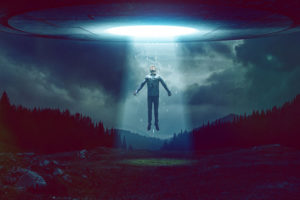Mermaids, Aliens, and Other Monsters: Bad Education or Harmless Entertainment?

Growing up, I enjoyed great science and learning programming on television channels such as the Discovery Channel, Animal Planet, the Science Channel, National Geographic and the History Channel. Shows like Blue Planet, Through the Wormhole with Morgan Freeman, Mutual of Omaha’s Wild Kingdom, and various miniseries about the past, present, and future offered a window of possibilities as well as challenges ahead in the real world. However, the content of these cable channels’ programming has since changed in a drastic, often outlandish way when it comes to presenting its audience with informative art and entertainment on science, history, technology, and engineering.
In 2010, a show debuted on the History Channel that alleged that the history and progress of humanity on Earth was greatly influenced by extra-terrestrial forces. Ancient Aliens, now in its fourteenth season, is a big success for the cable channel boasting more than 150 episodes. Featuring interviews with legitimate natural and social scientists alongside controversial paranormal “experts” or pseudoscientific commentators, nearly every episode claims that the majority of ancient or historical religions, sites, spiritual practices, and monuments were guided or influenced by extraterrestrials from outer space. From the Pyramids of Giza and Stonehenge to Machu Picchu and the Nazca Lines, the show perpetrates the idea that aliens helped ancient peoples with constructing these sites of history with advanced technology. Additionally, Ancient Aliens controversially theorizes that geniuses such as Leonardo da Vinci, Michelangelo, Nikola Tesla, Albert Einstein, Wernher von Braun, the American Founding Fathers, and Steve Jobs received their intellect from forces outside this world.
Obviously, this type of programming disregards the advancement humanity has made in science, technology, engineering, art, and society since the dawn of its own civilized beginnings. Furthermore, it can be argued that it diminishes the centuries of social and cultural developments of tribal or isolated peoples from around the world who are mostly non-white. Allowing the show to propose such a pseudo-scientific or pseudo-anthropological notion that nonhuman, sentient beings from different planets or star systems shaped or influenced nearly every place, idea, or person in history denies our own humanity and what it has accomplished both gradually and rapidly in a natural, materialistic world (as opposed to a paranormal or supernatural one).
It’s not just the History Channel that has a problem with promoting pseudoscience or pseudo-history to the masses. Animal Planet and its sister channels the Science Channel and the Discovery Channel have also faced controversy for broadcasting content that promotes creatures that only exist in myths and folklore. Programs like The Last Dragon and Werewolves: The Dark Survivors fictionalize the possibilities of fire-breathing flying reptiles and humanoid feral canines existing alongside humans, past and present. These same educational entertainment networks broadcast outlandish programs such as Mermaids: The Body Found, Russian Yeti: The Killer Lives, and Megalodon: The Monster Shark Lives that are presented and styled as realistic documentaries, even though they have no basis in evolutionary biological science. Mermaids even got so much attention when it was released in the spring of 2012 that the National Oceanic and Atmospheric Administration (NOAA) released a statement disclaiming the existence of mermaids and the aquatic ape theory which hypothesizes that human evolution diverged towards aquatic adaptation.
Such programs go the root of what we classify today as fake news or alternative fakes. Secularists must not only combat any form of religious and spiritual fundamentalism, or extremism, but also tackle social and cultural new ageism and pseudo-studies in the form of conspiracy theories and alternative medicines that have no basis in truth.
As more people become less religiously affiliated, these programs and their associated beliefs could be further utilized to promote pseudoscience and other untruths. As ordinary consumers, we should actively help young people to differentiate between factual programming on science and history channels and the fantastical, and often absurd forms of mass entertainment that surely help those particular networks stay in business. If we allow any media companies that once produced great learning content to peddle disinformation, history may repeat itself in troubling ways.
